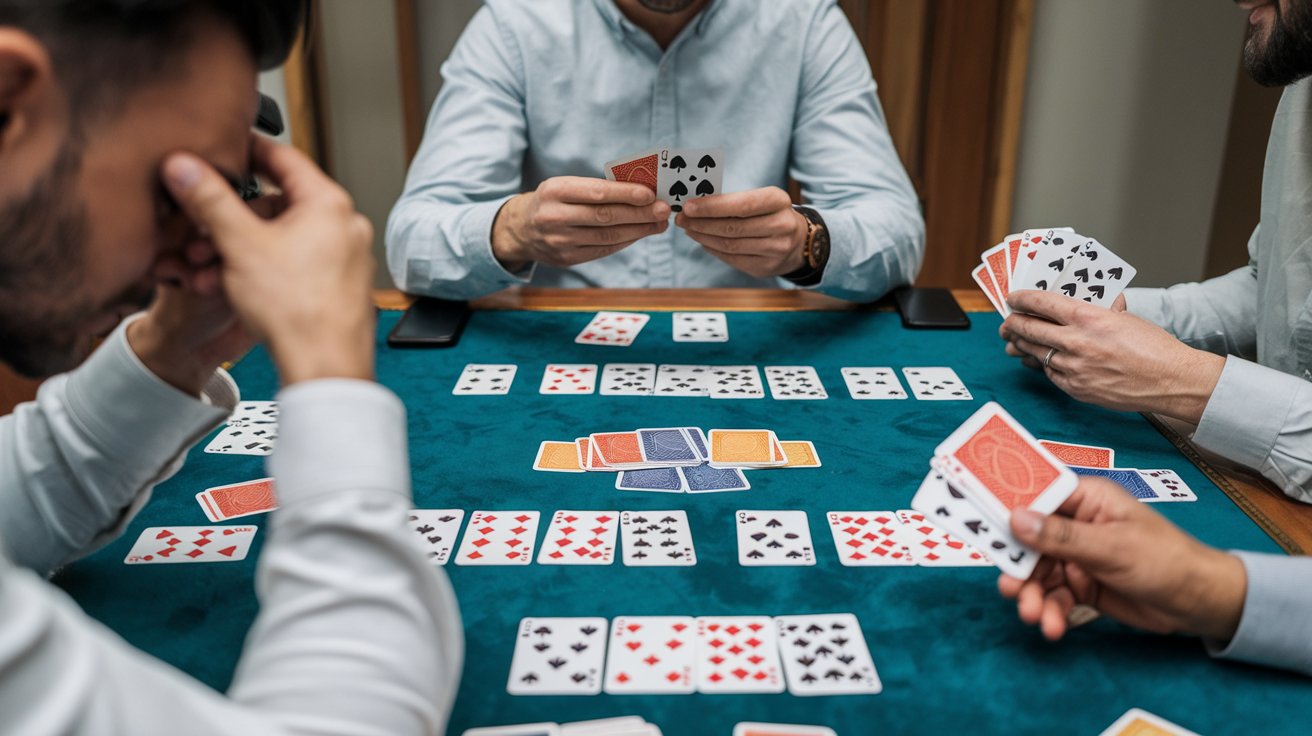Card games have been bringing friends and families together for centuries, providing entertainment that combines luck, skill, and strategy. Among the vast family of rummy games, Frustration Rummy stands out as a particularly engaging and aptly named variant that delivers both excitement and—as the name suggests—moments of delightful frustration. This comprehensive guide will walk you through everything you need to know about this challenging rummy variant, from basic setup to advanced strategies.
What Is Frustration Rummy?

Frustration Rummy is a multi-round card game that builds on the classic rummy framework while adding unique elements that increase complexity and strategic depth. What makes this variant particularly intriguing is its progressive contract system—each round requires players to fulfill increasingly difficult combinations of sets and runs, creating an escalating challenge that keeps players engaged from start to finish.
The game earned its name from the “frustrating” experience of watching another player go out just as you’re about to complete your hand—a common occurrence that adds to the game’s dramatic tension and competitive spirit.
Equipment Needed
Before diving into gameplay, here’s what you’ll need to gather:
- Cards: Two standard 52-card decks with jokers (104 cards plus 4 jokers total)
- Players: Best with 3-6 players (4-5 is optimal)
- Score pad and pencil: For tracking points across multiple rounds
- Playing surface: A table with enough space for everyone to lay out multiple card combinations
- Optional: Card holders for organizing larger hands
Basic Terminology
Understanding the following terms is essential for playing Frustration Rummy:
- Set: Three or more cards of the same rank but different suits (e.g., 8♠, 8♥, 8♦)
- Run: Four or more consecutive cards of the same suit (e.g., 5♥, 6♥, 7♥, 8♥)
- Contract: The specific combination of sets and runs required for each round
- Meld: The act of laying down a valid set or run
- Buy: Drawing an additional card by paying a point penalty
- Going out: Successfully playing all cards from your hand
- Deadwood: Cards remaining in your hand when someone goes out
The Structure of Frustration Rummy

What makes Frustration Rummy distinct is its multi-round structure with progressively challenging contracts. A typical game consists of seven rounds, each with specific requirements:
- Round 1: Two sets
- Round 2: One set and one run
- Round 3: Two runs
- Round 4: Three sets
- Round 5: Two sets and one run
- Round 6: One set and two runs
- Round 7: Three runs
The beauty of this structure is how it forces players to adapt their strategies from round to round, preventing the game from becoming repetitive.
Setting Up the Game
Follow these steps to begin a game of Frustration Rummy:
- Select a dealer: Each player draws a card; lowest card (Ace is low) becomes the dealer.
- Shuffle thoroughly: With two decks in play, proper shuffling is essential.
- Deal cards: The dealer distributes cards clockwise, one at a time.
- Round 1: 7 cards per player
- Round 2: 8 cards per player
- Round 3: 9 cards per player
- And so on, with each round adding one more card
- Create the stock pile: Place the remaining cards face-down in the center.
- Start the discard pile: Turn the top card from the stock pile face-up beside it.
- Begin play: The player to the dealer’s left takes the first turn.
Basic Gameplay Rules
On Your Turn
When it’s your turn in Frustration Rummy, you follow these steps:
- Draw a card: Either take the top card from the face-down stock pile or pick up the top card from the discard pile.
- Melding (optional): If you can complete the current round’s contract, you may lay down your melds. All required melds must be laid down simultaneously for your first meld of each round.
- Adding to melds (optional): After you’ve made your initial meld, you can add cards to your own or other players’ existing melds.
- Discard: End your turn by placing one card face-up on the discard pile.
Special Rules for Melding
Frustration Rummy has specific requirements for valid melds:
- Sets must contain: At least three cards of the same rank but different suits.
- Runs must contain: At least four consecutive cards of the same suit.
- First meld requirement: To make your first meld in a round, you must lay down all combinations required by the current contract simultaneously.
- Wild cards: Jokers can substitute for any card in a meld, with a typical limit of one wild card per meld.
- Aces: Can be high (after King) or low (before 2), but not both in the same run.
Going Out and Ending a Round
A round ends when one player “goes out” by:
- Completing the required contract
- Playing all remaining cards by adding them to existing melds (yours or others’)
- Discarding their final card
Once a player goes out, all other players count the point value of cards remaining in their hands.
Scoring System
Frustration Rummy uses a negative scoring system—lower scores are better, and the player with the lowest total after all rounds wins.
Card Values
- Jokers = 25 points each
- Face cards (J, Q, K) = 10 points each
- Aces = 15 points each
- Number cards = face value (e.g., 7 = 7 points)
Additional Scoring Rules
- If you haven’t melded when someone goes out, add a 25-point penalty
- Some variations award a 25-point bonus (subtracted from score) to the player who goes out
- After all seven rounds, the player with the lowest total score wins
Special Rules and Variations

Frustration Rummy has several common variations that add complexity and strategic depth:
The Buy Rule
In many variations, players can “buy” an extra card:
- After drawing your regular card, you can pay a 5-point penalty (added to your score)
- Draw an additional card from the stock pile
- You must still discard at the end of your turn
The Discard Pile Rule
Some versions have special rules for picking up from the discard pile:
- You can only take the top card of the discard pile if you can immediately use it in a meld
- Some variations allow picking up multiple cards from the discard pile if you can use the top card
Contract Variations
Different regions play with various contract sequences:
- Some add an eighth round requiring three sets and three runs
- Others modify the requirements for specific sets or runs (e.g., “two sets of 3” or “one run of 5”)
Strategic Tips for Success
1. Plan Ahead for Upcoming Rounds
Smart players think beyond the current round:
- Notice which cards might be useful for future contracts
- When possible, start building toward future requirements while completing current ones
2. Use Wild Cards Wisely
Wild cards are extremely valuable:
- Save them for completing difficult melds rather than using them for simple combinations
- In the later rounds, wild cards become even more precious as contracts get harder
3. Manage Your Hand Size
As rounds progress and hand sizes increase:
- Develop a system for organizing cards (by suit, by potential melds, etc.)
- Regularly reassess your hand after drawing new cards
4. Watch What Others Discard
Paying attention to discards provides valuable information:
- Note which cards opponents avoid picking up
- This reveals what they aren’t collecting and gives clues about their strategy
5. Strategic Discarding
Be thoughtful about what you discard:
- Avoid discarding cards that might help opponents
- When uncertain, discard high-value cards to minimize penalties if someone goes out
- Try to discard cards that are unlikely to help you complete your contract
6. Know When to Cut Your Losses
Sometimes the best strategy is damage control:
- If someone appears close to going out and you’re struggling to complete your contract
- Focus on discarding high-value cards to minimize your points for that round
7. The Art of the Buy
When to buy an extra card is a crucial decision:
- Buy when you’re one card away from completing your contract
- Buy when holding valuable wild cards but needing specific cards to use them
- Avoid buying late in the round when someone else seems close to going out
Challenges and How to Overcome Them
Managing Larger Hands
As the game progresses, hand size increases (up to 13 cards in round 7):
- Use card holders or fans
- Group cards by suits or potential melds
- Regularly reorganize after drawing new cards
Adapting to Changing Contracts
The shifting requirements between rounds challenge players to be flexible:
- In set-focused rounds, prioritize collecting matching ranks
- In run-focused rounds, concentrate on sequential cards of the same suit
- In mixed rounds, balance your approach
Dealing with Competition
When multiple players chase similar cards:
- Identify alternative strategies
- Be more aggressive in picking up needed cards
- Consider using wild cards to complete contested melds
Frequently Asked Questions
How long does a game of Frustration Rummy typically take?
A complete seven-round game usually takes 1.5-2 hours, depending on the number of players and their familiarity with the rules.
What’s the ideal number of players?
Frustration Rummy works best with 4-5 players. With fewer than 3, the game loses some competitive elements; with more than 6, play can become slow.
What if the stock pile runs out?
If the stock pile is depleted, shuffle the discard pile (except for the top card) to create a new stock pile.
Can you lay down partial melds?
No, your first meld in each round must fulfill the entire contract. After that, you can add to existing melds one card at a time.
How many wild cards can be used in a meld?
Most variations limit wild cards to one per natural meld, but house rules vary.
Etiquette and Fair Play
As with any social card game, good sportsmanship enhances everyone’s enjoyment:
- Avoid excessive delays when taking your turn
- Keep discards neat and visible to all players
- Don’t comment on others’ strategy or cards
- Help new players understand the rules without giving them unfair advantages
- Be gracious whether winning or losing
Teaching Frustration Rummy to New Players
When introducing the game to beginners:
- Start by explaining the basic concept of sets and runs
- Walk through a sample round with cards face-up
- Consider playing just the first 2-3 rounds for their first game
- Emphasize that strategy develops over time
Why Frustration Rummy Endures
Despite its sometimes challenging nature, Frustration Rummy remains popular for several compelling reasons:
Perfect Balance of Skill and Luck
While luck influences the cards you receive, skill determines how effectively you play them, creating a balanced experience that appeals to casual and serious players alike.
Escalating Challenge
The progressive round structure keeps the game fresh and engaging from start to finish, with each new round presenting a different puzzle to solve.
Social Dynamics
The game creates natural moments of tension, celebration, and yes—frustration—that make for memorable social interactions and friendly competition.
Accessibility with Depth
Basic rules are simple enough for older children and newcomers to grasp, while strategic nuances provide depth for experienced players.
Final Thoughts
Frustration Rummy earns its name through the challenging, sometimes maddening moments when victory seems just out of reach—but this same quality is precisely what makes it so addictively enjoyable. The game’s combination of progressive challenges, strategic depth, and social interaction has helped it endure as a favorite among card game enthusiasts.
Whether you’re looking to add variety to family game night or seeking a strategic challenge for your card-playing group, Frustration Rummy delivers an engaging experience that grows more rewarding with each play. The blend of luck, skill, and adaptation required ensures that every game tells its own unique story of near-misses, spectacular comebacks, and satisfying victories.
So shuffle the decks, deal the cards, and prepare yourself for an emotional roller coaster that somehow leaves you eager to play again, despite the frustrations you’ll inevitably encounter along the way!

Zareb Saleh is a journalist at Gulf Today and a ghostwriter for Gameoholic, specializing in gaming, technology, and digital culture. With a keen eye for industry trends, he delivers insightful stories that engage and inform readers.




